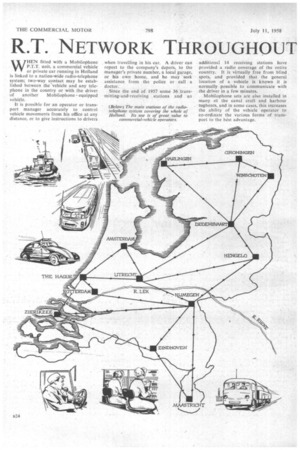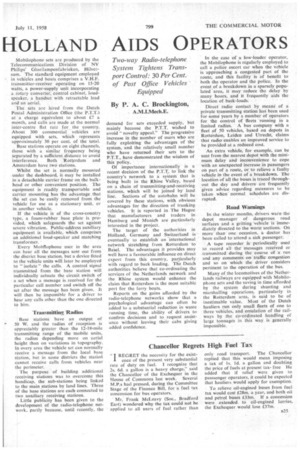R.T. NETWORK THROUGHOUT
Page 58

Page 59

If you've noticed an error in this article please click here to report it so we can fix it.
[-TOLLAND AIDS OPERATORS
By P. A. C. Brockington,
A.M.I.Mech.E. HEN fitted with a Mobilophonc
P.T.T. unit, a commercial vehicle or private car running in Holland is linked to a nation-wide radio-telephone system; two-way contact may be established between the vehicleand any telephone in the country or with the driver of another Mobilophone equipped vehicle.
It is possible for an operator or transport manager accurately to control vehicle movements from his office at any distance, or to give instructions to drivers
when travelling in his car. A driver can report to the company's depots, to the manager's private number, a local garage, or his own home, and he may seek assistance from the police or call a doctor.
Since the end of 1957 some 36 transmitting-and-receiving stations and an additional 14 receiving stations have provided a radio coverage of the entire country. It is virtually free from blind spots, and provided that the general location of a vehicle is known it is normally possible to communicate with the driver in a few minutes.
Mobilophone sets are also installed in many ot the canal craft and harbour tugboats, and in some cases, this increases the ability of the vehicle operator to co-ordinate the various forms of transport to the best advantage. Ivlobilophone sets are produced by the Telecommunications Division of NV Philips' Gloeilampenfabrieken, Hilversum. The standard equipment employed in vehicles and boats comprises a V.H.F. transmitter-receiver operating on 15-20 watts, a power-supply unit incorporating a rotary converter; control cabinet, loudspeaker, a handset with retractable lead and an aerial.
The sets are hired from the Dutch Postal Administration Office (the P.T.T.) at a charge equivalent to about £7 a month, and calls are made at the normal inter-centre flat rate for the country. About 300 commercial vehicles are equipped with sets, which represents approximately 30 per cent. of the total.
Base stations operate on eight channels, those with a similar frequency being separated by a sufficient distance to avoid interference. Both Rotterdam and Amsterdam have two stations.
Whilst the set is normally mounted under the dashboard, it may be installed in a detachable carrier frame on the bulkhead or other convenient position. The equipment is readily transportable and carrier mounting has the advantage that the set can be •easily removed from the vehicle for use as a stationary unit, or in another vehicle.
If the vehicle is of the cross-country type, a foam-rubber base plate is provided, which safeguards the set against severe vibration. Public-address auxiliary equipment is available, which comprises an additional loud-speaker and matching transformer..
Every Mobllophone user in the area can hear all the messages sent out from the district base station, but a device fitted to the vehicle units will later be employed to "isolate" the calls. A control signal transmitted from the base station will individually actuate the circuit switch of a set when a message is received for the particular call number and switch off the set after the message has been given. It will then be impossible for a driver to hear any calls other than the one directed to him.
Transmitting 'Radius Base stations have an output of 50 W. and the radius of reception is appreciably greater than the 12-18-mile transmitting range of the mobile units, the radius depending more on aerial height than on variations in topography. In every area the vehicle set can normally receive a message from the local base station, hut in some districts the station cannot receive calls from vehicles near the perimeter.
The purpose of building additional receiving stations was to overcome this handicap, the sub-stations being linked to the main stations by land lines. Three of the base stations are each connected to two auxiliary receiving stations.
Little publicity has been given to the development of the radio-telephone network. partly because, until recently, the demand for sets exceeded supply, but mainly because the .P.T.T. wished to avoid "novelty appeal." The progressive increase in the number of users who are fully exploiting the advantages of the system, and the relatively small number who have returned their sets to the P.T.T., have demonstrated the wisdom of this policy.
Of importance internationally is a recent decision of the P.T.T. to link the country's network to a system that is being built in the Rhine Valley, based on a chain of transmitting-and-receiving stations, which will be joined by land line. Sections of the autobahn will be covered by these stations, with obvious advantages for the direction of trunking vehicles. It is reported in The Hague that manufacturers and traders in Hamburg and Munich are particularly interested in the project.
The target of the authorities in Holland, Germany and Switzerland is eventually to establish an -international network stretching from Rotterdam to Basel. The advantages it provides may well have a favourable influence on direct export from this country, particularly with regard to back loading. The Dutch authorities believe that co-ordinating the services of the Netherlands network and the Rhine system would enhance the claim that Rotterdam is the most suitable port for the ferry boats.
Reports on the gains afforded by the radio-telephone networks show that a psychological advantage can often he added to a substantial reduction in waste running time, the ability of drivers to confirm decisions and to request assistance without leaving their cabs giving added confidence.
In the case of a low-loader operator, the Mobilophone is regularly employed to call a police escort car when the vehicle is approaching a congested part of the route, and this facility is of benefit to both the operator and the police. In the event of a breakdown in a sparsely populated area, it may reduce the delay by many hours, and it frequently aids the location of back-loads.
Direct radio contact by means of a private transmitting station has been used for some years by a number of operators for the control of fleets running in a limited radius. A bus company with a fleet of 50 vehicles, based on depots in Rotterdam, Leiden and Utrecht, claims that radio enables an improved service to be provided at a redUced cost.
An extra vehicle, for example, can be sent from the nearest depot with the minimum delay and inconvenience to cope with an unexpected increase in passengers on part of a route, or to relieve a faulty vehicle in the event of a breakdown. The location of all the buses is traced throughout the day and drivers are frequently given advice regarding measures to be taken when normal schedules are disrupted.
Road Warnings
In the winter months, drivers warn the depot manager of dangerous road surfaces and a gritting vehicle is immediately directed to the worst sections. On more than one occasion, a doctor has been called to attend a sick passenger.
A tape recorder is periodically used to record all the messages received or .transmitted during the course of a run and any comments on traffic congestion and so on which the driver considers pertinent to the operation of the bus.
Many of the locomotives of the Netherlands railways are equipped with Mobilophone sets and the saving in time afforded by the system during shunting and marshalling operations, particularly in the Rotterdam area, is said to be of inestimable value. Most of the Dutch hauliers run only small fleets of one to three vehicles, and emulation of the railways by the co-ordinated handling of large tonnages in this way is generally impossible. .




































































































